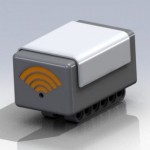
As a result of the Master class “LEGO beyond toys”, Sjef Franse, one of our master students, created a lego brick “WifiBlock” that connects the NXT to the Internet. The complete hardware and software design is described in his report:
Martijn ten Bhömer, Christoph Bartneck, Jun Hu, Rene Ahn, Tuyls, Karl, Frank Delbressine, and Loe Feijs
Abstract – Lego Mindstorms NXT is a platform highly suitable for prototyping in the field of interactive social robotics. During a technology masterclass at Eindhoven University of Technology students from the department of Industrial Design have developed five novel extensions (sensors and actuators) for the Lego Mindstorms NXT which extend the ability of Lego to prototype for robotics even further. Applications include a water-pump, GPS sensor, wireless sensor bridge, optical mouse sensor and a magnetic grabber. In this paper we will present these extensions and showcase applications in which these extend possibilities of Lego Mindstorms NXT to a new level.
Keywords: robot, Lego, Mindstorms, NXT, social, prototyping
Bram van der Vlist, Rick van de Westelaken, Christoph Bartneck, Jun Hu, Rene Ahn, Emilia Barakova, Frank Delbressine, and Loe Feijs
Abstract – Machine learning is a key technology to design and create intelligent systems, products, and related services. Like many other design departments, we are faced with the challenge to teach machine learning to design students, who often do not have an inherent affinity towards technology. We successfully used the Embodied Intelligence method to teach machine learning to our students. By embodying the learning system into the Lego Mindstorm NXT platform we provide the student with a tangible tool to understand and interact with a learning system. The resulting behavior of the tangible machines in combination with the positive associations with the Lego system motivated all the students. The students with less technology affinity successfully completed the course, while the students with more technology affinity excelled towards solving advanced problems. We believe that our experiences may inform and guide other teachers that intend to teach machine learning, or other computer science related topics, to design students.
Keywords: teaching, machine learning, design, lego
I was really satisfied with what the master students have achieved last week. They have done
more than I expected during that “pattern recognition” week – in their hands the
LEGO can even do OCR and Speech Recognition. They consolidated their knowledge of
machine learning and neural networks that were learnt from previous weeks, and used these techniques for pattern recognition.
[youtube]http://www.youtube.com/watch?v=1P9uMcTBJUU[/youtube]